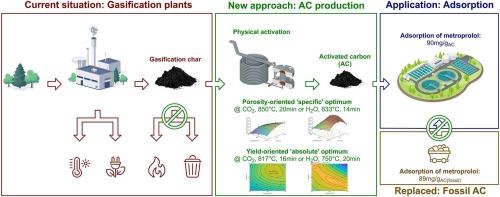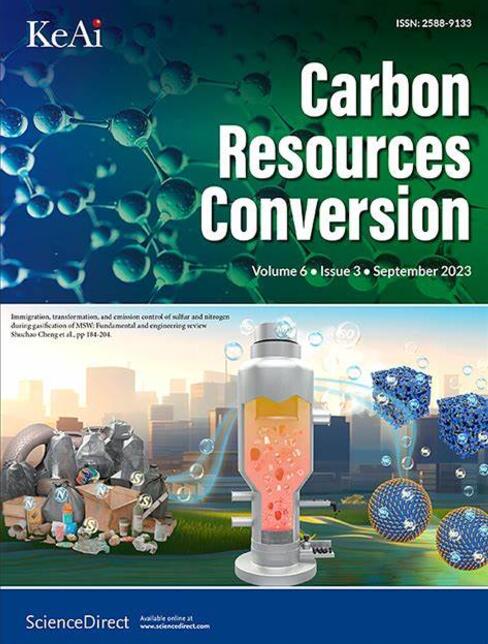Renewable activated carbon from wood-based gasification char: A comprehensive study on physical activation
IF 7.5
3区 环境科学与生态学
Q2 ENERGY & FUELS
引用次数: 0
Abstract
Wood gasification produces gasification char (GC), a carbonaceous by-product with limited sustainable valorisation strategies. The physical activation of wood-based GC as a precursor has received insufficient attention, likely due to the inherent challenges associated with the precursor, namely its soft skeleton, high degree of graphitisation, ash content, and reduced porosity. This study investigates methods to enhance the porosity and adsorption properties of renewable activated carbon (AC) derived from GC while maximising yield using a Design of Experiments approach. Yield-oriented porosity optimisation revealed that mild H2O activation (750 °C, 20 min) was the most effective, followed by CO2 activation at 817 °C and 16.2 min. The AC with the highest overall porosity was produced by sequential activation, leveraging the high surface area obtained from H2O activation (812 m2/g) and the high micropore fraction from CO2 activation (49.3 vol%). In micropollutant adsorption assays, this AC (maximum adsorption capacity for metoprolol: ) partially outperformed commercial AC (). We found that the utilisation of GC for AC production represents a fundamentally distinct starting point when compared to previously employed precursors, as evidenced by significantly reduced activation times and temperatures. This study provides valuable insights for the efficient conversion of GC into high-value AC, a pathway of significant interest for industrial applications.

木质气化炭再生活性炭:物理活化的综合研究
木材气化产生气化炭(GC),这是一种碳质副产品,具有有限的可持续增值策略。木质GC作为前驱体的物理活化受到的关注不够,可能是由于前驱体固有的挑战,即其柔软的骨架、高度的石墨化、灰分含量和减少的孔隙率。本研究利用实验设计的方法,探讨了提高气相色谱再生活性炭(AC)的孔隙率和吸附性能,同时最大化收率的方法。面向产量的孔隙度优化显示,温和的H2O活化(≥750°C,小于或等于20分钟)是最有效的,其次是817°C和16.2分钟的CO2活化。具有最高总体孔隙度的AC是通过顺序活化产生的,利用从H2O活化获得的高表面积(812 m2/g)和从CO2活化获得的高微孔分数(49.3 vol%)。在微污染物吸附试验中,该AC(对美托洛尔的最大吸附量qmax: 89.9mg/g)部分优于商用AC (89.1mg/g)。我们发现,与以前使用的前体相比,GC用于AC生产代表了一个根本不同的起点,这可以通过显著降低激活时间和温度来证明。这项研究为GC高效转化为高价值AC提供了有价值的见解,这是工业应用的重要途径。
本文章由计算机程序翻译,如有差异,请以英文原文为准。
求助全文
约1分钟内获得全文
求助全文
来源期刊

Carbon Resources Conversion
Materials Science-Materials Science (miscellaneous)
CiteScore
9.90
自引率
11.70%
发文量
36
审稿时长
10 weeks
期刊介绍:
Carbon Resources Conversion (CRC) publishes fundamental studies and industrial developments regarding relevant technologies aiming for the clean, efficient, value-added, and low-carbon utilization of carbon-containing resources as fuel for energy and as feedstock for materials or chemicals from, for example, fossil fuels, biomass, syngas, CO2, hydrocarbons, and organic wastes via physical, thermal, chemical, biological, and other technical methods. CRC also publishes scientific and engineering studies on resource characterization and pretreatment, carbon material innovation and production, clean technologies related to carbon resource conversion and utilization, and various process-supporting technologies, including on-line or off-line measurement and monitoring, modeling, simulations focused on safe and efficient process operation and control, and process and equipment optimization.
 求助内容:
求助内容: 应助结果提醒方式:
应助结果提醒方式:


